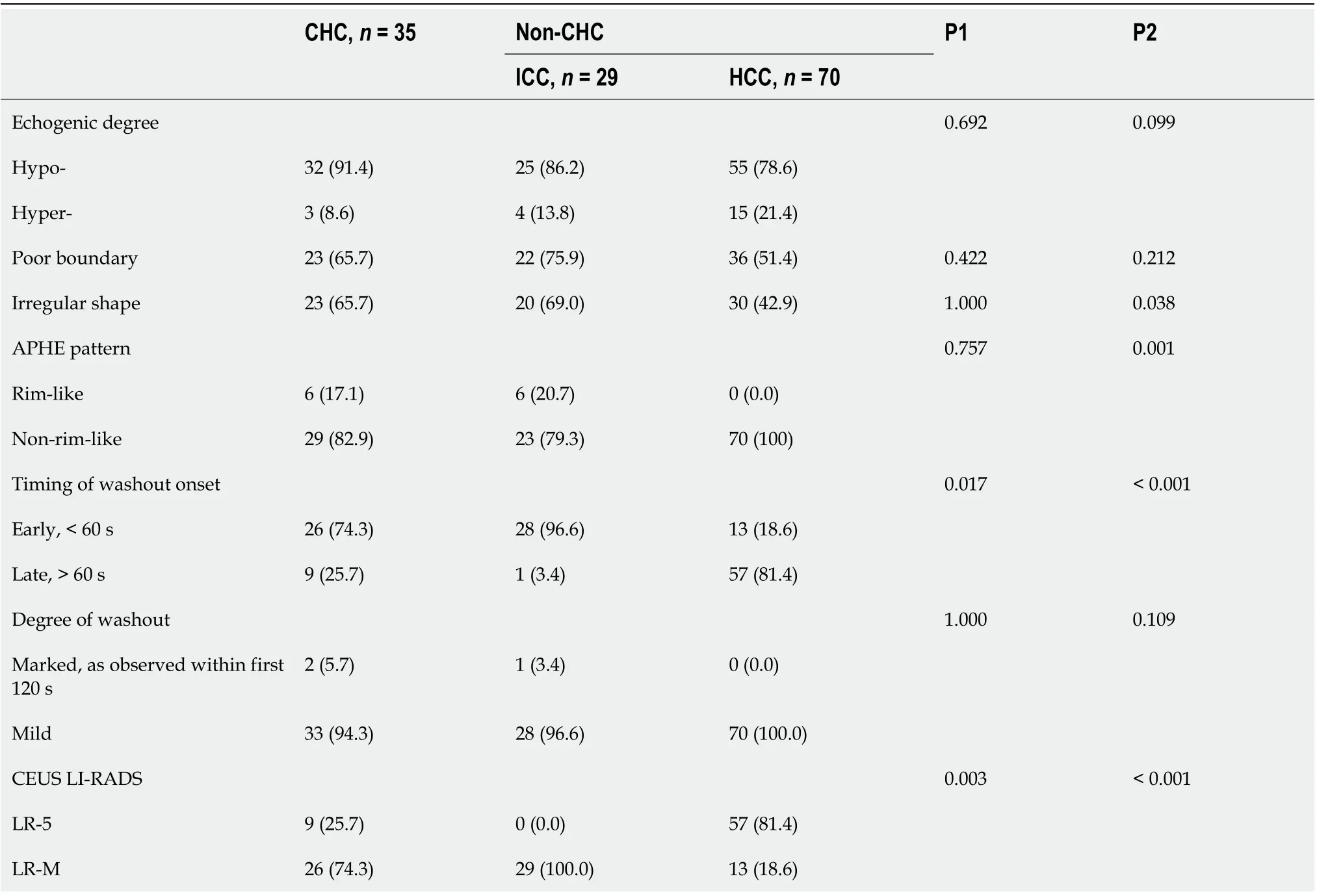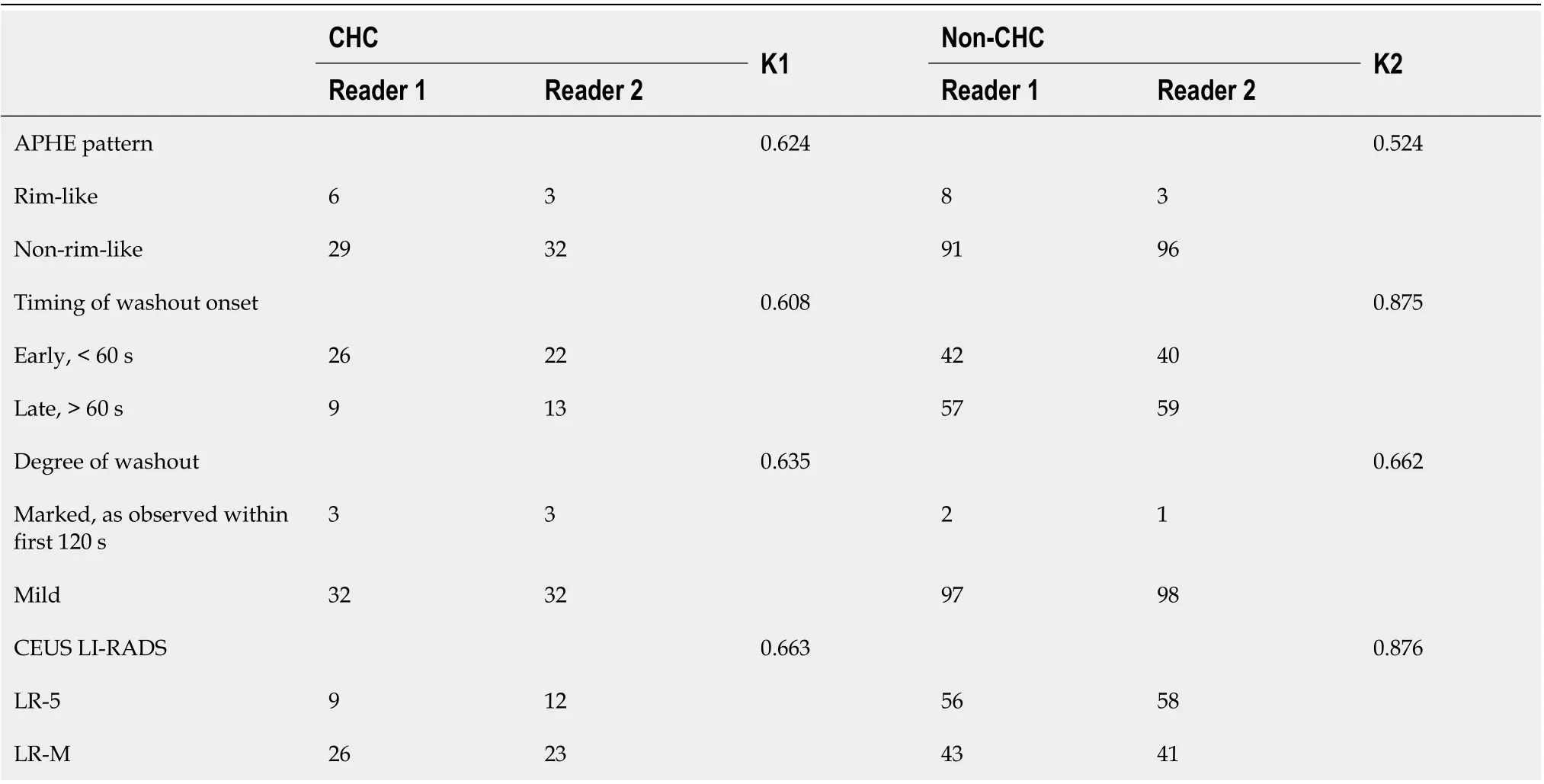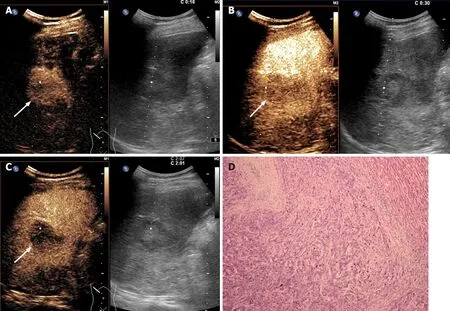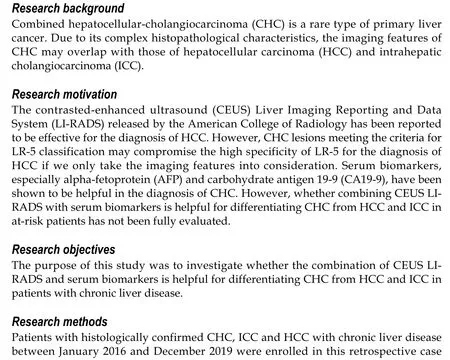Contrast-enhanced ultrasound in association with serum biomarkers for differentiating combined hepatocellular-cholangiocarcinoma from hepatocellular carcinoma and intrahepatic cholangiocarcinoma
Jie Yang, Ya-han Zhang, Jia-Wu Li, Ying-Yu Shi, Jia-Yan Huang,'Yan Luo, Ji-Bin Liu, Qiang Lu
Abstract
Key Words: Combined hepatocellular-cholangiocarcinoma; Contrast-enhanced ultrasound; Liver imaging reporting and data system; Sensitivity; Diagnosis; Liver neoplasms
INTRODUCTION
Combined hepatocellular-cholangiocarcinoma (CHC) is increasingly recognized in cirrhotic liver, with a reported prevalence of 0.4%-14.2% of all primary liver carcinomas[1-3]. CHC is the second most common primary liver cancer in cirrhotic liver, followed by intrahepatic cholangiocarcinoma (ICC), excluding perihilar cholangiocarcinoma[4]. According to the 2010 World Health Organization classification[5], this special type of tumor requires the presence of both unambiguously differentiated hepatocellular and biliary components. CHC can have various imaging features overlapping with hepatocellular carcinoma (HCC), ICC and liver metastasis for complex histopathological components[6-8]. However, the prognosis and treatment of CHC differ from those of HCC and ICC[9], and therefore the accurate diagnosis of this tumor type is of great importance for appropriate patient management.
A few studies have reported the imaging features of CHC lesions on contrastenhanced ultrasound (CEUS)[10-13]. Theoretically, due to the mixed elements of CHC,especially alpha-fetoprotein (AFP) and carbohydrate antigen 19-9 (CA19-9), have been shown to be helpful in the diagnosis of CHC[10,11,13,14]. The combination of CEUS and serum biomarkers was reported to improve specificity for the differentiation between CHC and HCC or ICC in a study population not limited to patients at risk for HCC[10].
The American College of Radiology released CEUS Liver Imaging Reporting and Data System (LI-RADS) for standardizing CEUS diagnosis of liver nodules in high-risk patients[15]. Although not fully validated, CEUS LI-RADS has been reported to be effective for the diagnosis of HCC[16,17]. However, challenges still exist for the differential diagnosis of highly suspicious HCC and other malignant entities, such as CHC and ICC. The purpose of this study was to investigate whether the combination of CEUS LI-RADS and serum biomarkers is helpful for differentiating CHC from HCC and ICC in patients with chronic liver disease.
MATERIALS AND METHODS
Study subjects
This retrospective study was approved by the institutional review board, and informed consent was obtained from all patients. From January 2016 to December 2019, patients with pathologically confirmed primary liver cancer after liver resection were retrospectively selected through a review of our Ultrasonic Information System. Inclusion criteria included: (1) CEUS performed within 1 mo before liver resection; (2) Patients with risk factors for HCC, including cirrhosis and chronic hepatitis B; and (3) Testing of AFP and CA19-9 levels within 7 d before curative resection. Lesions with neoplastic vascular thrombi were excluded from this study. Eventually, we included 35 CHC, 29 ICC and 1051 HCC patients. After one-to-two (CHC:HCC = 1:2) propensity score matching by tumor size, age and gender, 70 HCC lesions were selected for analysis. A flow chart for the study population selection is presented in Figure 1.
Ultrasound examination
All patients underwent B-mode ultrasound and CEUS examination by an ultrasound system (IU22, Philips Medical Solutions; Mountain View, CA, United States) equipped with a C5-1 abdominal convex transducer (frequency range of 1-5 MHz). The CEUS examination was performed according to technical recommendations following the World Federation for Ultrasound in Medicine and Biology-European Federation of Societies for Ultrasound in Medicine and Biology guidelines after a conventional ultrasound study[18]. After activation of the contrast-specific imaging mode, 1.2-2.4 mL of contrast agent (SonoVue, Bracco, Milan, Italy) was injected intravenously and flushed with 5 mL of 0.9% saline solution through a 20-gauge angio-catheter needle placed in the antecubital vein. The imaging timer was started immediately upon completion of SonoVue injection. The set of images was stored on the hard disk of the ultrasound system and copied to a portable hard disk for later evaluation.
CEUS imaging analysis
According to the CEUS LI-RADS (2017 version), a hepatic nodule is categorized from LR-1 to LR-5 or LR-M and LR-TIV according to the likelihood of HCC[17]. The following imaging features were used to categorize each nodule: Nodule size, pattern of arterial phase enhancement, presence, timing and degree of washout and tumor-in-vein (Supplementary Appendix Table 1).
The CEUS images were reviewed independently by two certified radiologists (Li JW and Shi YY with more than 5 and 3 years of experience with liver CEUS, respectively) who were blinded to the pathology results and serum biomarker levels and assigned a category to each nodule according to CEUS LI-RADS (2017 version)[15,17]. In case of discordant interpretations between the reviewers, arbitration from an expert radiologist with more than 10 years of experience (Lu Q) was performed.
Diagnostic criteria for distinguishing CHC from HCC or ICC
The diagnostic criteria of CHC were defined as follows: (1) LR-5 or LR-M lesion with simultaneously elevated AFP and CA19-9 (AFP > 20 ng/mL and CA19-9 > 100 units/mL) levels[19-21]; (2) LR-M lesion with elevated AFP levels and normal CA19-9 Levels; or (3) LR-5 lesion with elevated CA19-9 levels and normal AFP levels. The diagnostic test was performed with pathological results as the reference standard.

Figure 1 Study population selection flowchart. AFP: Alpha-fetoprotein; CA19-9: Carbohydrate antigen 19-9; CEUS: Contrast-enhanced ultrasound; CHC: Combined hepatocellular-cholangiocarcinoma; HCC: Hepatocellular carcinoma; ICC: Intrahepatic cholangiocarcinoma.
Statistical analysis
Quantitative data were expressed as the mean ± standard deviation. Qualitative data were presented as numbers and percentages. Differences in quantitative variables were tested by the independent samplet-test. Comparison of the rates of imaging characteristics was performed by using theχ2test or Fisher’s exact test. The area under the receiver operating characteristic curve (AUC) was used to analyze the performance of the diagnostic criteria. The sensitivity, specificity, accuracy, positive predictive value (PPV) and negative predictive value (NPV) for CHC were calculated by using standard procedures[22].
Kappa values were evaluated to measure intrareader agreement of CEUS features and CEUS LI-RADS classification of the nodules. The strength of agreement was interpreted according to the classification scales for kappa: 0.00-0.20 poor, 0.21-0.40 fair, 0.41-0.60 moderate, 0.61-0.80 substantial and 0.81-1.00 almost perfect[23]. Propensity score matching was performed with R software version 3.6.1 (R Foundation for Statistical Computing, Vienna, Austria; www.r-project.org). Statistical analyses were performed with the statistical software package SPSS, version 25.0; IBM, Armonk, NY, United States). Significance was defined as two-sidedP< 0.05.
RESULTS
Patient characteristics
After propensity score matching, a total of 35 CHC, 29 ICC and 70 HCC patients were included for analysis. The clinical characteristics of the 134 patients are shown in Table 1. In the CHC group, the mean nodule size was 5.6 ± 3.7 cm (range 2.0-17.0 cm) in diameter. Elevated AFP levels were found in 51.4% (18/35) of CHC patients, in contrast to 10.3% (3/29) of ICC patients and 58.6% (41/70) of HCC patients (P= 0.001 and 0.535, respectively). In addition, elevated CA19-9 levels were found in 11.4% (4/35) of CHC patients compared with 31.0% (9/29) of ICC patients and 1.4% (1/70) of HCC patients (P= 0.066 and 0.041, respectively). Simultaneous elevations in AFP and CA19-9 were found in 8.6% (3/35) of CHC, 3.4% (1/29) of ICC and 1.4% (1/70) of HCC patients (P> 0.05).
CEUS imaging characteristics
All the CHC lesions illustrated hyperenhancement in the arterial phase and hypoenhancement in the portal or late phase. In the arterial phase, peripheral irregular rimlike and non-rim-like hyperenhancement were demonstrated in 17.1% (6/35) and 82.9% (29/35) of CHC lesions, respectively. In the portal phase, early washout waspresent in 74.3% (26/35) of CHC lesions compared with 96.6% (28/29) of ICC lesions (P= 0.017) and 18.6% (13/70) of HCC patients (P< 0.001). Marked washout within 120 s was found in 5.7% (2/35) of CHC lesions, in contrast to 3.4% (1/29) of ICC lesions (P= 1.000) and none of the HCC lesions (P= 0.109). According to CEUS LI-RADS, 25.7% (9/35) and 74.3% (26/35) of CHCs were classified as LR-5 and LR-M, respectively, in contrast to none and 100% in ICC (P= 0.003) and 81.4% (57/70) and 18.6% (13/70) in HCC (P< 0.001). The pre-contrast and contrast-enhanced ultrasonographic imaging features are presented in Table 2.

Table 1 Baseline characteristics of the study patients with combined hepatocellular-cholangiocarcinoma, intrahepatic cholangiocarcinoma and hepatocellular carcinoma
The interobserver agreement of CEUS features for the CHC and non-CHC groups is summarized in Table 3. In the CHC group, the k values of interobserver agreements on the arterial phase hyperenhancement pattern, early washout and marked washout were 0.624, 0.608 and 0.635, respectively. In the non-CHC group, the k values of interobserver agreements on arterial enhancement pattern, early washout and marked washout were 0.524, 0.875 and 0.662, respectively. The k values of CEUS LI-RADS categorization in the two groups were 0.663 and 0.876, respectively.
Performance of CHC diagnostic criteria in distinguishing between CHC and HCC or ICC
Serum tumor biomarkers (AFP and CA19-9) and the CEUS LI-RADS categorization of the 134 patients are shown in Table 4 (Figure 2-4). Table 5 shows the performance of the diagnostic criteria. The AUC, sensitivity, specificity, PPV, NPV, and accuracy were 0.649, 40.0%, 89.9%, 58.3%, 80.9% and 76.9%, respectively. In this study, CHC accounted for 26.1% (35/134) of the study population, yielding an adjusted PPV of 58.3% and NPV of 80.9%. However, the actual prevalence of CHC is much lower, reportedly accounting for 0.4%-14.2% of primary hepatic cancers[2,24,25]. Considering eighth reported prevalence of CHC (0.4%-14.2%), the PPV and NPV were modified to 1.6%-39.6% and 90.1%-99.7%, respectively.
DISCUSSION
CHC is the second most common type of primary liver cancer in cirrhotic liver[4]. A definitive diagnosis of CHC requires both unambiguously differentiated hepatocellular and biliary components in the same tumor in pathological analysis as per the World Health Organization classification[5]. However, biopsy may misguide the correct diagnosis of CHC due to sampling error or tissue insufficiency[26,27], which highlights the importance of surgical specimens and imaging diagnosis. Our study indicated that a higher percentage of CHC was classified as LR-M than LR-5 (74.3%vs25.7%,P< 0.05). Simultaneous elevation of AFP and CA19-9 was present in only 8.6%(3/35) of CHC patients. The combination of CEUS LI-RADS and serum AFP and CA19-9 levels showed a specificity of 89.9% and accuracy of 76.9% for the diagnosis of CHC in patients with chronic liver disease.

Table 2 Imaging characteristics of the study patients with combined hepatocellular-cholangiocarcinoma and those with intrahepatic cholangiocarcinoma and hepatocellular carcinoma, n (%)
In our study, all CHC lesions showed typical manifestations of liver cancer (i.e.the enhancement mode of “rapid wash in and out”)[10-12,28]. However, 74.3% (26/35) of CHC cases were assessed as LR-M, which is higher than the rates reported by Choiet al[29](28.0%) and Jeonet al[30](61.4%) based on magnetic resonance imaging (MRI) LI-RADS. This discrepancy may be explained by the fact that early washout is more easily observed by CEUS due to higher temporal resolution than MRI. In this study, the other 25.7% (9/35) of CHC lesions were classified as LR-5. In other words, 100% of CHC lesions were correctly classified as malignant by CEUS LI-RADS, which is in line with the findings of Sagriniet al[12], where CEUS correctly suggested a condition of malignancy in a higher number of cases than CT and MRI for the diagnosis of CHC.
Elevated AFP and CA19-9 levels have been reported as potential diagnostic indicators for HCC and ICC, respectively[19,31]. Prior studies have demonstrated that the combination of AFP and CA19-9 with radiologic characteristics may aid the diagnosis of CHC[10,11,13,14]. Huanget al[10]reported that the sensitivity and specificity of diagnosing CHC based on their criteria (i.e.simultaneous elevation of AFP and CA19-9 or with a tumor marker elevation in discordance with HCC-like or ICC-like pattern on CEUS), were 32.5% and 92.8%, respectively, which is comparable to the result of our study. Compared with Huang’s study, HCC lesions were selected by propensity score matching in this study, which reduced patient selection bias. Moreover, CEUS LIRADS was adopted in our criteria, which makes it more standardized to use in the clinical setting.
The diagnostic criteria for CHC showed high specificity (89.9%) and modified NPV (90.1% to 99.7%), which indicated that CHC could be effectively ruled out by using CEUS LI-RADS. Atypical HCC or ICC would be classified as LR-M, a categoryindicating malignancy but not specific for HCC. Biopsy is recommended for the management of LR-M lesions. However, for CHC, the value of biopsy may be limited due to sampling error or tissue insufficiency. In such a scenario, combining CEUS LIRADS with serum biomarkers could confidently exclude the possibility of CHC if the lesion does not meet the criteria. However, the performance of the diagnostic criteria in this study indicated that differentiation between CHC and HCC or ICC remains challenging.

Table 3 The inter-observer agreement of contrasted-enhanced ultrasound features for the combined hepatocellularcholangiocarcinomas and non-combined hepatocellular-cholangiocarcinomas lesions

Table 4 Contrast-enhanced ultrasound Liver Imaging Reporting and Data System categorization and serum biomarkers of 134 patients
There are a few limitations to our study. First, this was a single-center retrospective case-control study, which may have potential selection bias. Additional multicenter prospective studies are needed to validate the diagnostic criteria. Second, the sample size was small because of the relatively low incidence of CHC tumors. Third, this study mainly enrolled patients with chronic hepatitis B. Therefore, our results may not be reproducible in patients with other etiologies, especially liver cirrhosis.

Table 5 Diagnostic test results and modified positive predictive value and negative predictive value according to reported combined hepatocellular-cholangiocarcinoma prevalence

Figure 2 LR-M nodule in a 54-year-old man with chronic hepatitis B. A: A nodule with a diameter of 3.6 cm in the right liver lobe was homogeneously hyper-enhanced (arrow) in the arterial phase at contrast-enhanced ultrasound; B: Early washout (53 s) of the contrast agent was observed (arrow); C: Hypoenhancement (arrow) in the late phase was shown at contrast-enhanced ultrasonography. Elevated alpha-fetoprotein and normal carbohydrate antigen 19-9 level were found by in the serologic data. The nodule was assigned to combined hepatocellular-cholangiocarcinoma lesion according to the diagnostic criteria; D: Both hepatocellular carcinoma (orange arrow) and intrahepatic cholangiocarcinoma (yellow arrow) components were found in histopathologic analysis, resulting in a final diagnosis of combined hepatocellular-cholangiocarcinoma (hematoxylin and eosin staining; magnification, × 100).
CONCLUSION
In conclusion, CHC could be accurately diagnosed as malignant by CEUS LI-RADS, with the majority of the lesions in the LR-M category. The combination of CEUS LIRADS classification with serum tumor markers shows high specificity but low sensitivity for the diagnosis of CHC. These findings could help radiologists and clinical investigators confidently exclude CHC lesions in the clinical setting.

Figure 3 LR-M nodule in a 55-year-old woman with chronic hepatitis B. A: A hypoechoic nodule with a diameter of 3.4 cm in the left lobe of the liver was homogeneously hyper-enhanced (arrow) in the arterial phase; B: Early washout was observed at 32 s after injection of contrast agent (SonoVue; Bracco); C: Hypoenhancement of the whole nodule was demonstrated in the late phase. Serologic data indicated normal alpha-fetoprotein and carbohydrate antigen 19-9 levels. The nodule was assessed as non-combined hepatocellular-cholangiocarcinoma lesion according to the diagnostic criteria; D: The nodule was proved to be hepatocellular carcinoma by pathology (hematoxylin and eosin staining; magnification, × 100).

Figure 4 LR-M nodule in a 46-year-old man with chronic hepatitis B. A: A hypoechoic nodule with a diameter of 3.9 cm in the right lobe of the liver was heterogeneously hyper-enhanced (arrow) in the arterial phase; B: Early washout (30 s) of the contrast agent was observed (arrow); C: Hypo-enhancement of the nodule (arrow) in the late phase was shown at contrast-enhanced ultrasound. The patient had both normal alpha-fetoprotein and carbohydrate antigen 19-9 levels. The lesion was classified as non-combined hepatocellular-cholangiocarcinoma lesion according to the diagnostic criteria; D: Intrahepatic cholangiocarcinoma and cirrhosis of the surrounding liver were confirmed by pathology (hematoxylin and eosin staining; magnification, × 100).
ARTICLE HIGHLIGHTS


Research results
After propensity score matching, 134 patients (mean age of 51.4 ± 9.4 years, 108 men) were enrolled, including 35 CHC, 29 ICC and 70 HCC patients. Based on the CEUS LIRADS classification, 74.3% (26/35) and 25.7% (9/35) of CHC lesions were assessed as LR-M and LR-5, respectively. The rates of elevated AFP and CA19-9 levels in CHC patients were 51.4% and 11.4%, respectively. Simultaneous elevation of AFP and CA19-9 was found in 8.6% (3/35) of CHC patients. The sensitivity, specificity, positive predictive value (PPV), negative predictive value (NPV), accuracy and AUC of the aforementioned diagnostic criteria for discriminating CHC from HCC and ICC were 40.0%, 89.9%, 58.3%, 80.9%, 76.9% and 0.649, respectively. When the reported prevalence rate of CHC (0.4%-14.2%) was taken into account, the PPV and NPV were revised to 1.6%-39.6% and 90.1%-99.7%, respectively.
Research conclusions
CHCs are more likely to be classified as LR-M than LR-5 by CEUS LI-RADS. The combination of the CEUS LI-RADS classification with serum tumor markers shows high specificity but low sensitivity for the diagnosis of CHC. Moreover, CHC could be confidently excluded with a high NPV.
Research perspectives
The imaging features of CHC are complicated due to its complex histopathological characteristics. In addition, biopsy may misguide the correct diagnosis of CHC due to sampling error or tissue insufficiency. This study investigated the diagnostic value of the CEUS LI-RADS classification combined with serological tumor markers in differentiating CHC from HCC and ICC. The results showed that the combined diagnostic criteria had high specificity and NPV but low sensitivity for the diagnosis of CHC. These findings could help radiologists and clinical investigators confidently exclude CHC lesions in the clinical setting.
ACKNOWLEDGEMENTS
We thank all medical staff and technicians of dialysis centers who agreed to participate in this study.
 World Journal of Gastroenterology2020年46期
World Journal of Gastroenterology2020年46期
- World Journal of Gastroenterology的其它文章
- Response of gut microbiota to serum metabolome changes in intrahepatic cholestasis of pregnant patients
- Untargeted metabolomics characteristics of nonobese nonalcoholic fatty liver disease induced by hightemperatureprocessed feed in Sprague-Dawley rats
- Effect of postoperative early enteral nutrition on clinical outcomes and immune function of cholangiocarcinoma patients with malignant obstructive jaundice
- Extrahepatic bile duct reconstruction in pigs with heterogenous animal-derived artificial bile ducts: A preliminary experience
- Value of shear wave elastography with maximal elasticity in differentiating benign and malignant solid focal liver lesions
- Challenges in COVID-19 drug treatment in patients with advanced liver diseases: A hepatology perspective
